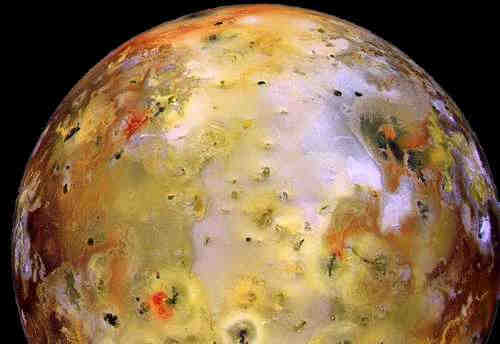New photographs reveal surprising geological phenomena on one of Jupiter's moons
Tamara Traubman

Spectacular volcanic eruptions, a huge bubbling lava lake, clouds of toxic gases and molten rocks ejected from geysers - this is what a typical day looks like on Io, one of Jupiter's moons. These sights were revealed at the end of the week, with the publication of the photographs sent by the Galileo spacecraft, which studies Jupiter and some of its moons.
Io is the body with the most volcanic activity in the entire solar system. "By Earth's standards, Io is a world where there is no pleasant, relaxed day," said Alfred McEwan, a planetary geologist at the University of Arizona. McEwan authored a report, which was published this weekend in the scientific journal "Science" about the images sent by Galileo.
"Io is like a large-scale volcanic laboratory," he said. "It's a place where we can observe geological changes, and really understand how they happen. With these insights, we can go back and re-examine what happened in the past on Earth."
From the data that Galileo sent it turned out that the volcano Prometheus on Io is quite similar to the volcanoes in Hawaii, but much more active and larger. On the other hand, unlike on Earth, most of the craters on Io have very straight edges and their lips are jagged (similar to a chimney).
The atmosphere of Io is extremely thin, and it consists mainly of the poisonous gas sulfur dioxide. Its diameter is about 3,600 kilometers, slightly larger than the Earth's moon.
Io is one of the closest moons to Jupiter. According to McEwan, this proximity, along with Jupiter's enormous gravitational pull, has far-reaching implications for the moon. Most of the land on the surface of Io is not solid (lava, and molten rocks). McEwan says that every 42 hours, every point on Io goes from high tide to low tide, and the surface rises and falls by about 100 meters. Tides play a major role in creating the intense volcanic activity on Io.
"Lots of earthquakes happen there," says John Spencer of the Lowell Observatory in Arizona who studies the moon. "If we were in Iyo, everything around us would rise and fall by several tens of meters every day. It was like being on a ship in the heart of the ocean."
It is still not clear how thick the lunar mantle is, and to what underground layer the molten rocks ejected to the surface in the form of lava reach. But McEwan says the crust needs to be at least a few tens of kilometers thick to support the impressive mountain ranges on the moon. "It has mountains almost twenty kilometers high," he says. "It requires a strong membrane."
Indeed, one of the still unsolved mysteries is how the mountains in Io were formed. They rise to a height of about 16 kilometers, "however, despite the much volcanic activity in Ayo, they are not volcanoes," the researchers write. "There are no vents of volcanoes in them. They look like blocks that have been displaced from the crust surrounding Io."
"Ayo is fascinating because everything we see in it is completely new and completely unexpected," says Jenny Redbrow of the University of Arizona. In every picture that comes from there, we see that something new is happening, which we don't understand."
{Appeared in Haaretz newspaper, 21/5/2000{
The other side of the moon is Io
30/08/1999
"Cosmic pizza" - this is how NASA scientists describe the shape of the moon Io, as it is obtained from the latest images transmitted by the Galileo spacecraft, which orbits the planet
"Cosmic pizza" - this is how NASA scientists describe the shape of the moon Io, as it is a space obtained from the latest images transmitted by the Galileo spacecraft, orbiting the planet Jupiter. Io is the closest moon to Jupiter, among the four major moons of the planet. The photos were taken on July 3 when the spacecraft passed, for the first time since it approached Jupiter in 1995, at a distance of only 130 thousand km from the moon Io. This is about a third of the distance between the Earth and the Moon.
In the images, published by NASA only last Friday, we can see one of the sides of the star, which has never been photographed from such a short distance. "These are the best pictures of the wrong side of Jupiter," said the project's scientific director, Thorence Johnson. The Voyager spacecraft did indeed pass by Jupiter and Io in 1979, but at that time it only took high resolution images of the side facing Jupiter. In the previous images taken by Galileo, the surface facing away from Jupiter appeared as spots. Now they look even more mottled, especially in the areas around the volcanoes of Io. Io is the most volcanic object in the solar system and this gives it a particularly smooth surface, due to the accumulation of lava, the scientists say.
The scientists are particularly interested in the volcano known as Prometheus, which shoots snow and small particles of dust, which appear as a plume, to a height of 75 to 100 km. Prometheus was discovered by Voyager in 1979 and has continued to be active ever since, producing a sprinkler effect. The center of the volcano has moved, since it was discovered, 75 km towards the west. In the pictures from the mountain area, tiny shadows in lemon-yellow, light green and chestnut colors are visible. Flight engineers are now changing Galileo's orbit, so that it will once again pass near the moon Io, in October or November. The spacecraft is programmed so that it can approach to a distance of only 500 km from Io, after passing several times on its way by another moon of Jupiter, Callisto.
